|
Cruise Introduction
 The Yangtze River has been a top tourist destination in China ever since
it became possible to visit. I remember seeing a picture of Bill Clinton
enjoying a short cruise back when he was president, though I now wonder
what he was doing out here in the middle of nowhere. The Yangtze is one
of the world's great rivers, starting in the Himalayas and making its way
over 6000km across southern China before emptying into the sea around
Shanghai. Over 1000km inland from Shanghai, in the Hubei province, the
river passes through three impressive gorges. Like many tourists, I
signed-up for a three-day journey down a 600km section of river from
Chongquin to Yinchang in order to see some of the scenery. A second class
ticket for a bed in a room with three other people cost me just over
50USD, but including food, optional tours and whatnot, I spent maybe
100USD in all.
The Yangtze River has been a top tourist destination in China ever since
it became possible to visit. I remember seeing a picture of Bill Clinton
enjoying a short cruise back when he was president, though I now wonder
what he was doing out here in the middle of nowhere. The Yangtze is one
of the world's great rivers, starting in the Himalayas and making its way
over 6000km across southern China before emptying into the sea around
Shanghai. Over 1000km inland from Shanghai, in the Hubei province, the
river passes through three impressive gorges. Like many tourists, I
signed-up for a three-day journey down a 600km section of river from
Chongquin to Yinchang in order to see some of the scenery. A second class
ticket for a bed in a room with three other people cost me just over
50USD, but including food, optional tours and whatnot, I spent maybe
100USD in all.
Trevor, Family, Kids
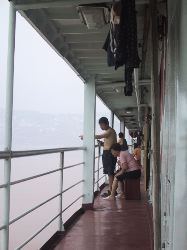 As with my hike up Mt. Emei, the people on this boat trip really made it
worth it. I just happened to be booked in a room with a British guy named
Trevor who has been studying Chinese in Beijing for the last year or so.
He previously taught English in Korea and is also working on a masters in
economics and politics. He was a great companion for the three days and
also helped me understand China a bit more. Also, since he spoke some
Chinese, we were able to communicate a bit with the family that occupied
the other bunk bed in our room. This husband, wife, and one kid came all
the way from Guangdong to enjoy see what all the tourists are raving
about. They were so friendly and defied almost all of the negative
stereotypes that I can imagine about Chinese people (except the ones about
rotten only-child syndrome kids). Trevor also managed to become friends
with four university students who were using the boat as their return
ticket to school in Wuhan. There were also countless other people who
walked up to us to say hello, take a picture, and practice their English.
As with my hike up Mt. Emei, the people on this boat trip really made it
worth it. I just happened to be booked in a room with a British guy named
Trevor who has been studying Chinese in Beijing for the last year or so.
He previously taught English in Korea and is also working on a masters in
economics and politics. He was a great companion for the three days and
also helped me understand China a bit more. Also, since he spoke some
Chinese, we were able to communicate a bit with the family that occupied
the other bunk bed in our room. This husband, wife, and one kid came all
the way from Guangdong to enjoy see what all the tourists are raving
about. They were so friendly and defied almost all of the negative
stereotypes that I can imagine about Chinese people (except the ones about
rotten only-child syndrome kids). Trevor also managed to become friends
with four university students who were using the boat as their return
ticket to school in Wuhan. There were also countless other people who
walked up to us to say hello, take a picture, and practice their English.
Mingshan Temples and Ghost City
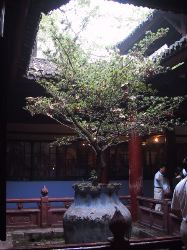 After setting-off about 8pm on the 23rd, we arrived bright and early at
our first historical sight. Mingshan, or Mt. Ming, is a hillside which
has been covered with Buddhist temples for some time. Honestly, when
traveling in Asia you get tired of temples about as quickly as you tire of
churches in Europe. The unique thing about temples in China is that
people burn absorbitant amounts of incense, fake money, and other
decorations to the point of having legitimate fire hazards. Although
Taoism, Confucianism, and Buddhism have all been adopted as the official
state religion at some point in the past, the communists prefer to
suppress religion and this has contributed to the growing religious
indifference of most Chinese today. Most of the Chinese tourists (and our
boat is 95% Chinese) seem more like tourists than worshippers as we file
through from hall to hall listening to the explanations from the tour
guides. The Ghost City, though, turns out to be much more of a tourist
trap. Supposedly this area has some mysterious past linking it to the
appearance of all kinds of spirits, but it is now home to a
Disneyland-wannabe haunted mansion complete with a little car ride inside
the castle walls. I decided to skip most of the on-shore antics after
this one.
After setting-off about 8pm on the 23rd, we arrived bright and early at
our first historical sight. Mingshan, or Mt. Ming, is a hillside which
has been covered with Buddhist temples for some time. Honestly, when
traveling in Asia you get tired of temples about as quickly as you tire of
churches in Europe. The unique thing about temples in China is that
people burn absorbitant amounts of incense, fake money, and other
decorations to the point of having legitimate fire hazards. Although
Taoism, Confucianism, and Buddhism have all been adopted as the official
state religion at some point in the past, the communists prefer to
suppress religion and this has contributed to the growing religious
indifference of most Chinese today. Most of the Chinese tourists (and our
boat is 95% Chinese) seem more like tourists than worshippers as we file
through from hall to hall listening to the explanations from the tour
guides. The Ghost City, though, turns out to be much more of a tourist
trap. Supposedly this area has some mysterious past linking it to the
appearance of all kinds of spirits, but it is now home to a
Disneyland-wannabe haunted mansion complete with a little car ride inside
the castle walls. I decided to skip most of the on-shore antics after
this one.
Three Gorges
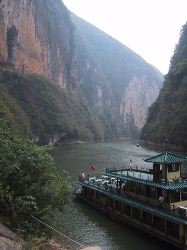 The main event, of course was seeing the three gorges themselves. We
passed through the Qutang Gorge on the second day and then saw the Wu
Gorge and Xiling Gorge early morning on the third day. In between, we had
a side trip up a tributary to see the Mini Three Gorges and then the Mini
Mini Three Gorges. This sounds a bit cheesy, but this was actually fun
because we were on really small boats in a narrow valley for the mini-mini
part and the 70+ aged guide was singing old mountain songs reminiscent of
Swiss yodelers. Singing aside, the gorges all reminded me of Lake Powell
in the western US. The Glen Canyon Dam in the US backed-up the Colorado
River just a bit downstream from the Grand Canyon. The result is a long
narrow lake with a lot of inlets and steep rocky walls which are ideal for
cliff diving. The Yangtze (damn or no damn) has the same steep canyon
walls plus the added bonus view of many farms and small towns along the
way (the Lake Powell is mostly uninhabited).
The main event, of course was seeing the three gorges themselves. We
passed through the Qutang Gorge on the second day and then saw the Wu
Gorge and Xiling Gorge early morning on the third day. In between, we had
a side trip up a tributary to see the Mini Three Gorges and then the Mini
Mini Three Gorges. This sounds a bit cheesy, but this was actually fun
because we were on really small boats in a narrow valley for the mini-mini
part and the 70+ aged guide was singing old mountain songs reminiscent of
Swiss yodelers. Singing aside, the gorges all reminded me of Lake Powell
in the western US. The Glen Canyon Dam in the US backed-up the Colorado
River just a bit downstream from the Grand Canyon. The result is a long
narrow lake with a lot of inlets and steep rocky walls which are ideal for
cliff diving. The Yangtze (damn or no damn) has the same steep canyon
walls plus the added bonus view of many farms and small towns along the
way (the Lake Powell is mostly uninhabited).
Three Gorges Dam
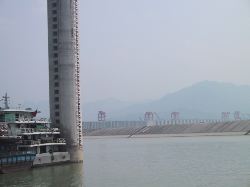 The other major reason I wanted to take this trip this year is due to the
construction of the huge dam just downstream of the gorges. Typical of
China, there is a lot of misinformation about the status of the dam
project and what impact it will have on the three gorges area. Some
people say that this trip will no longer be possible (or at least, not
interesting) after the dam is completed. Others believe it is already too
late. As far as I can tell, the dam is basically completed, although the
last "ship elevator" and some of the power generators will not be
operational for a couple more years. The dam will eventually raise the
water in the gorges area from about 90m (above sea level) to 156.3m in the
summer and 175m in the winter. However, so far the water stands at only
about 135m. All along the river people are working frantically to move
the last of the 1,000,000+ residents whose houses will be covered by the
water. Some entire villages were relocated while others just creeped up
the hill a bit. Most of the current work seems to be concentrating on
reinforcing the steep riverbanks which will soon be overrun with water.
It is a very impressive project to watch and ponder and seems like
something only the Chinese would try.
The other major reason I wanted to take this trip this year is due to the
construction of the huge dam just downstream of the gorges. Typical of
China, there is a lot of misinformation about the status of the dam
project and what impact it will have on the three gorges area. Some
people say that this trip will no longer be possible (or at least, not
interesting) after the dam is completed. Others believe it is already too
late. As far as I can tell, the dam is basically completed, although the
last "ship elevator" and some of the power generators will not be
operational for a couple more years. The dam will eventually raise the
water in the gorges area from about 90m (above sea level) to 156.3m in the
summer and 175m in the winter. However, so far the water stands at only
about 135m. All along the river people are working frantically to move
the last of the 1,000,000+ residents whose houses will be covered by the
water. Some entire villages were relocated while others just creeped up
the hill a bit. Most of the current work seems to be concentrating on
reinforcing the steep riverbanks which will soon be overrun with water.
It is a very impressive project to watch and ponder and seems like
something only the Chinese would try.
The Five Locks
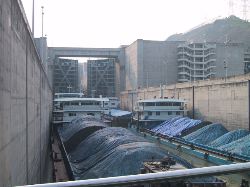 Aside from flood control and power generation, the third goal of the dam
project is to improve navigation along this corridor. With the extra
width and depth of the river all the way up to Chongquin, it will be
possible to sail 10,000-ton barges (big, I guess) with no problem. Well,
the one problem is the big dam in the middle of the river. That is why
they built this five-step system of locks which will raise (or lower)
ships from the 175m reservoir level to the 85m downstream level. Each
lock can hold six large ships at a time. When the 40m-high doors are
closed behind you, the water level goes down about 20m until you are level
with the water in the next lock. Then the doors in front of you slowly
swing open (while you hum evil Darth Vador music) and the boats move
forward into the next lock. It was fun the first time, but after five
locks, you start wishing they had the elevator completed so they could
lower the boat in one quick movement!
Aside from flood control and power generation, the third goal of the dam
project is to improve navigation along this corridor. With the extra
width and depth of the river all the way up to Chongquin, it will be
possible to sail 10,000-ton barges (big, I guess) with no problem. Well,
the one problem is the big dam in the middle of the river. That is why
they built this five-step system of locks which will raise (or lower)
ships from the 175m reservoir level to the 85m downstream level. Each
lock can hold six large ships at a time. When the 40m-high doors are
closed behind you, the water level goes down about 20m until you are level
with the water in the next lock. Then the doors in front of you slowly
swing open (while you hum evil Darth Vador music) and the boats move
forward into the next lock. It was fun the first time, but after five
locks, you start wishing they had the elevator completed so they could
lower the boat in one quick movement!
--By the Way--
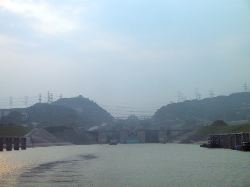 I never managed to remember much about the geography of China on previous
trips. When traveling here, everything seems so immense with people all
over and most of the names seem unfamiliar and confusing. However, an
easy way to think about the China is via its similarity to the US. The
landsize is about the same (though the population of China is more than 4X
the US!) and the layout is similar too. Most of the people live on the
east coast. The three major cities break-up the country into what is
sometimes referred to as Northern China (Beijing), Eastern China
(Shanghai), and Southern China (Hong Kong). North and east of Beijing
there are still plenty of big cities, kinda like Boston and whatnot. As
you move west there are still tons of major cities with more than 4
million people each. Many of these are provincial capitals. Since there
are only about 25-30 provinces (give or take special municipalities,
autonomous regions, etc), each one has 30-60million people each. The far
western provinces are huge, but have fewer people because they are covered
by deserts and mountains, just like the US. Today, after getting off the
boat, I spent an hour in the city of Wuhan before flying to Beijing. This
random city of 8million likes to think of itself as the
Chicago of China.
I never managed to remember much about the geography of China on previous
trips. When traveling here, everything seems so immense with people all
over and most of the names seem unfamiliar and confusing. However, an
easy way to think about the China is via its similarity to the US. The
landsize is about the same (though the population of China is more than 4X
the US!) and the layout is similar too. Most of the people live on the
east coast. The three major cities break-up the country into what is
sometimes referred to as Northern China (Beijing), Eastern China
(Shanghai), and Southern China (Hong Kong). North and east of Beijing
there are still plenty of big cities, kinda like Boston and whatnot. As
you move west there are still tons of major cities with more than 4
million people each. Many of these are provincial capitals. Since there
are only about 25-30 provinces (give or take special municipalities,
autonomous regions, etc), each one has 30-60million people each. The far
western provinces are huge, but have fewer people because they are covered
by deserts and mountains, just like the US. Today, after getting off the
boat, I spent an hour in the city of Wuhan before flying to Beijing. This
random city of 8million likes to think of itself as the
Chicago of China.
Aaron Bishop
27 August 2006
|






